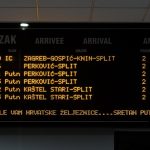Croatian tourism: from the looks of things, it’s going great. But while many of our coastal cities are breaking records left and right, is this really enough to become the European metropolises of Barcelona, Prague or Berlin? Slobodna Dalmacija contributor Ružica Mikačić weighs in on the current situation in Split on February 1, 2017.
Perhaps the biggest star of Croatian tourism recently is Split. But when taking a closer look – despite double-digit growth in tourist arrivals and overnight stays which helped the city to break records over the last few years – it seems that Split is even further from becoming the next European tourist metropolis because it lacks the full range of attributes most large and well-known city-break destinations already have.
Ružica Mikačić writes that without any intention to prejudice the undeniable successes of the tourist city of Split – which has passed a long and difficult path to return to the market as an attractive Mediterranean metropolis – it is important however to note what it lacks in order to be able to compare it with cities that have the best tourist services such as Barcelona, Prague, Madrid, Berlin, London, and Paris.
Here is some of what Mikačić suggests should change or be implemented in Split in an effort to achieve the success of a true European metropolis.
A convention and concert center: No large tourist city is without a convention center. Without a convention center, how might one assemble serious international meetings, organize conferences outside the main season, or accommodate the potential of big concerts? Unfortunately, as things stand now, Split will not be getting a multifunctional center for a long time, but for the future it would crucial to create conditions for hosting year-round business people and events, including year-round tourists.
Shortage of hotel beds: While private initiatives have placed 17,000 beds in apartments, hostels and rooms on the market – to be a big tourist town – one must have at least 3,000 beds in hotels. These are the criteria held in more than a hundred city-break destinations throughout the world, as confirmed by lead organization European Cities Marketing (ECM) which brings together representatives of city tourism. Unlike the rest, Split unfortunately has little more than 2,000 hotel beds that are predominantly in small and family-run hotels.
Issue of municipal infrastructure: The issue of municipal infrastructure still rests on the capacity of the city 50 years ago, but more specifically, Split has not yet managed to organize a way to charge tourist buses. Mikačić writes that more than one hundred tour buses arrive daily to the Riva in the season, and upon entering the city they are charged nothing. Most of these guests, much like everywhere else in Europe, would happily pay one euro for a tour program, and tourist buses throughout Europe are already typically charged around 50 euros. And as it stands now, buses can stop and park anywhere around the city without any control or penalties – something that true tourist cities would never allow.
Lack of international cuisine: In the restaurants and kitchens of some of the biggest European tourist cities it is ubiquitous to have Chinese, Asian, Italian, and Spanish specialties. While it’s always nice to provide indigenous and local fare, guests should be given the opportunity to occasionally choose something else. We can say this is slowly but surely happening in the city.
Finally, direct air links with Europe to Split in the winter are more than modest, and trust us – there are plenty of European tourists who would decide to take a long weekend in Diocletian’s city in the winter. As it stands now, there are few off-season flight options, with guests most likely preferring travel to other Mediterranean metropolises because of it.
What do you think needs to change in Split in order to achieve becoming the ultimate European tourist metropolis?









